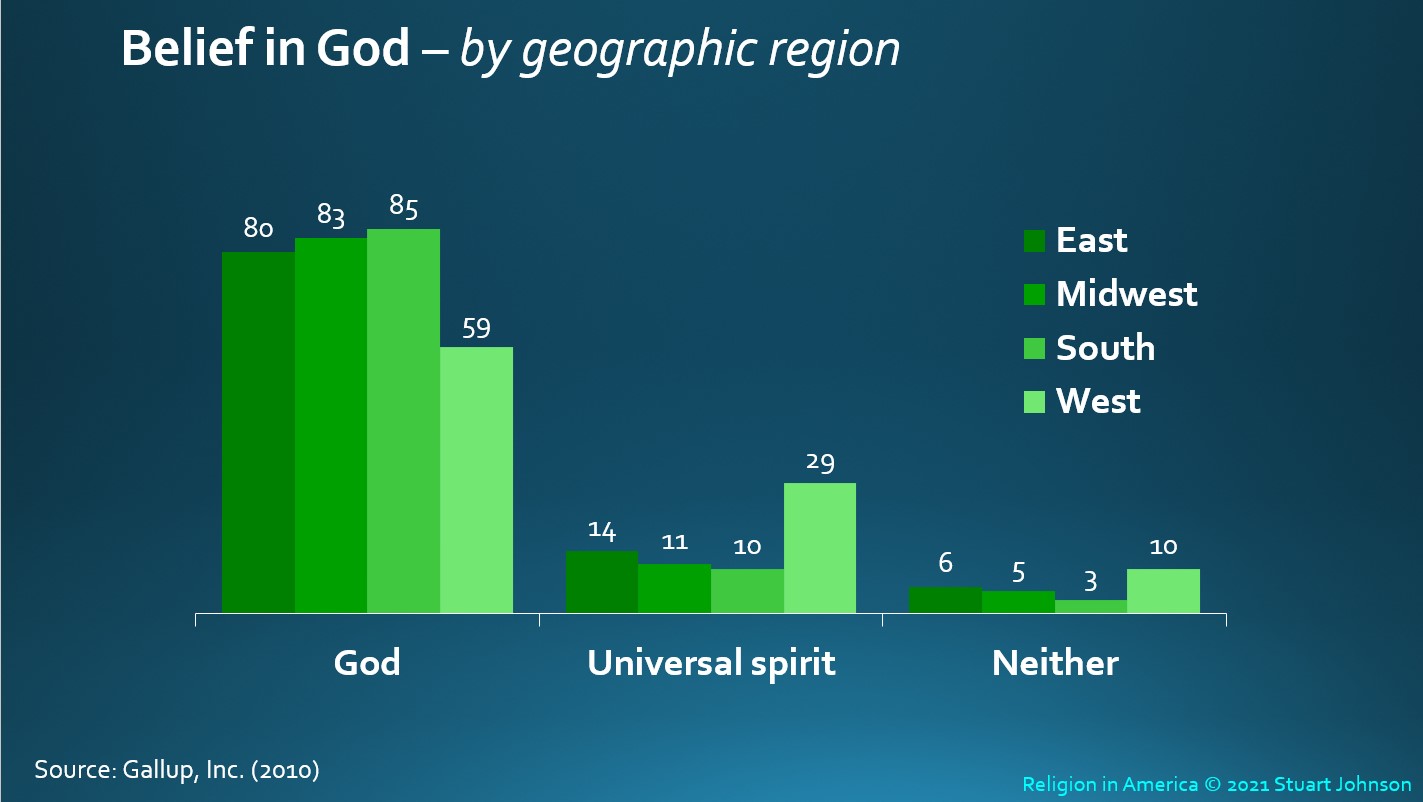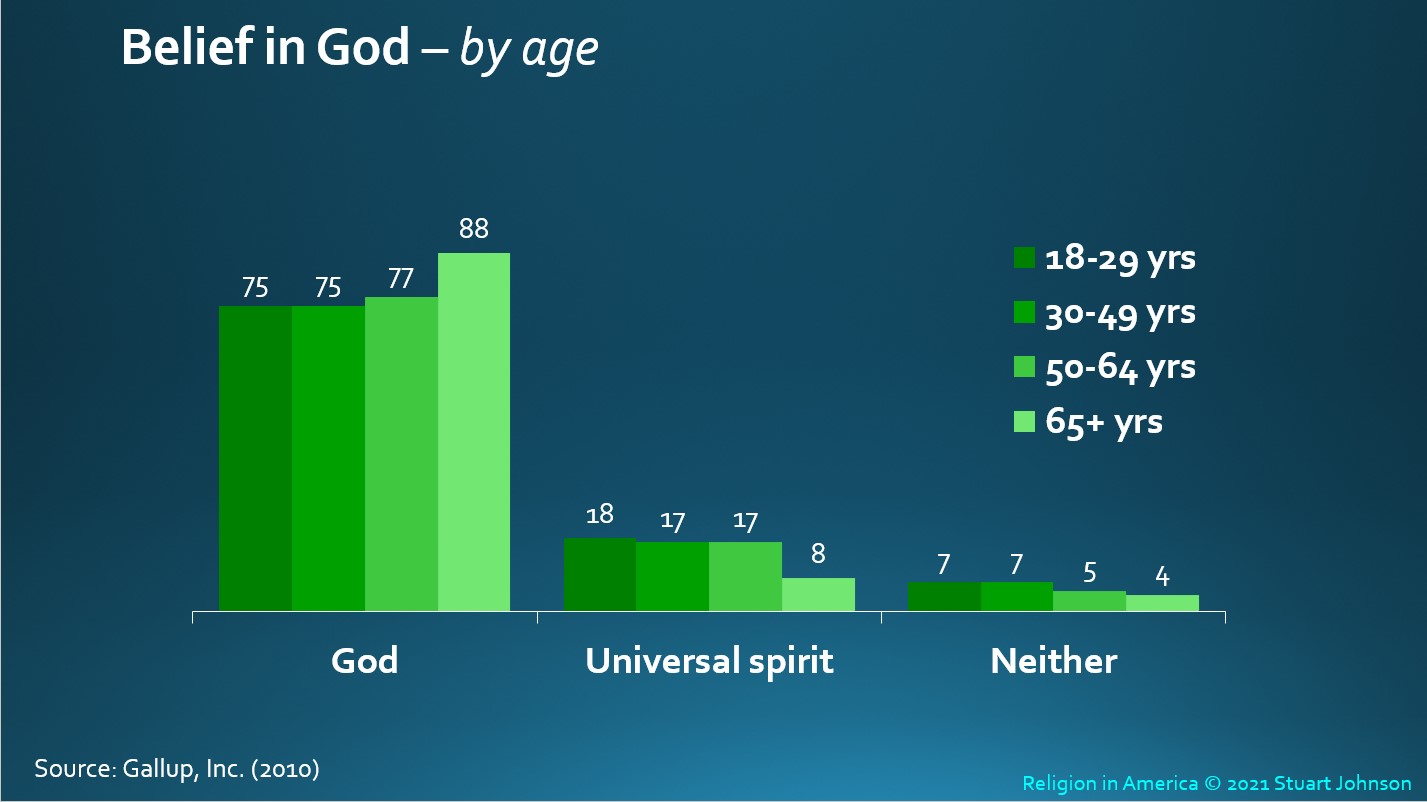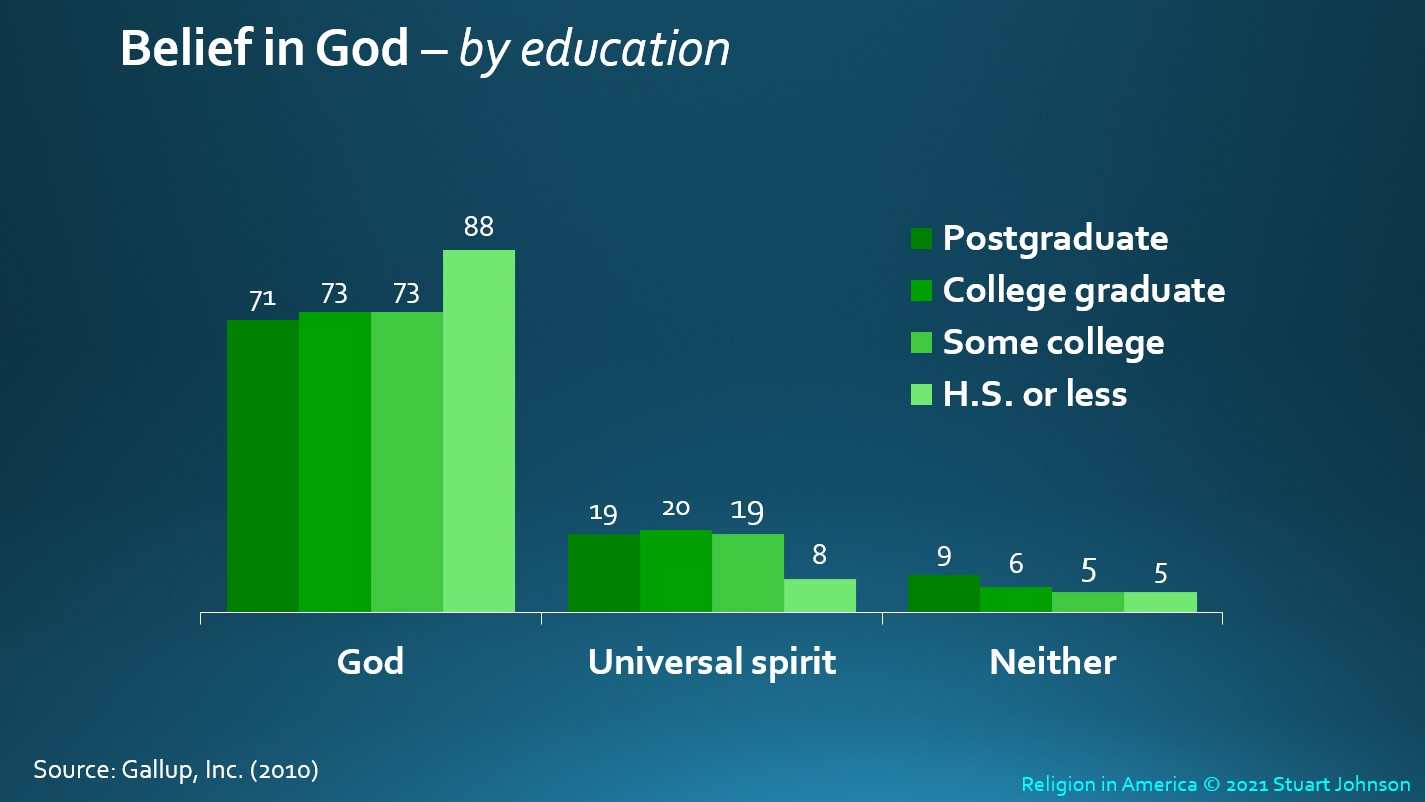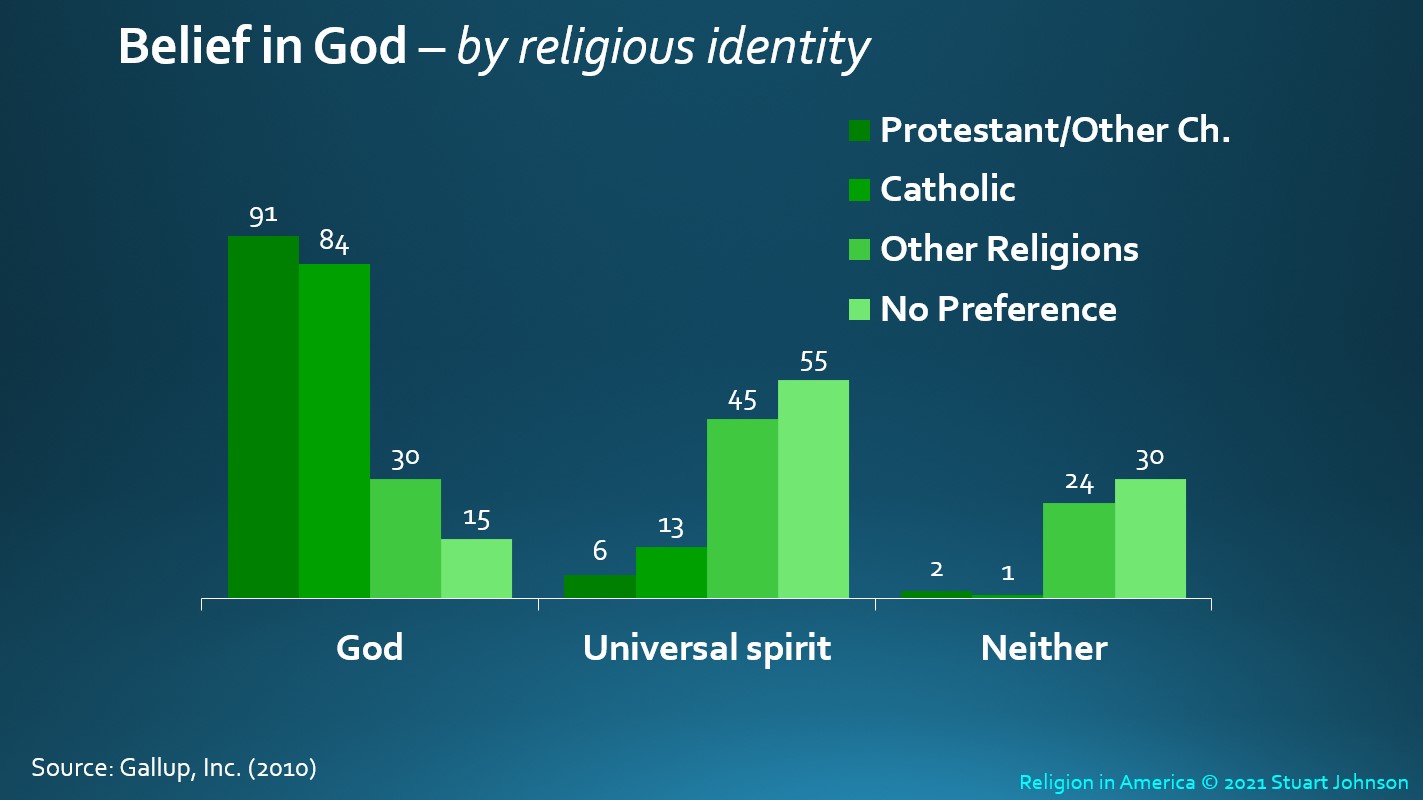
Making Information Make Sense
Religion in America
Digging Deeper: Beliefs
updated June 2021
< back to Religion in America summary
Summary
The charts that follow are based on Gallup surveys dealing with several aspects of belief in God:
- God, the Devil, Angels, Heaven and Hell (Figure 1, comparing four Gallop surveys from 2001 to 2016) - Belief is weakening, but remains in the majority. Disbelief and uncertainty are most evident across the four surveys in beliefs about the Devil and Hell, though the rate of increase in disbelief and uncertainty is strongest for belief in God, Angels and Heaven.
- Confidence in Belief in God (Figure 2, comparing four Gallop surveys from 2005 to 2017) - Those convinced God exists declined from 80% to 64%, while those who say Probably, but have doubts nearly doubled, from 11% to 21%. Also doubling were those who are convinced God does not exist or say Probably Not.
- Demographic characteristics (Figures 3-6, from a 2010 Gallop survey) - This survey distinguished between belief in God and a Universal Spirit. We know the numbers have drifted down since then, but the pattern is likely to be similar:
- Region - 80% or more believed in God in the South, Midwest and East. In the West, 59% believed in God, 29% in a Universal Spirit and 10% in Neither.
- Age - 88% of those 65+ claimed a belief in God, 8% in a Universal Spirit. Other age groups fell in the 75-77% range for belief in God, and 17-18% for belief in a Universal Spirit.
- Education- paralleling the numbers for Age, 88% of those with high school or less claim a belief in God and 8% a Universal Spirit. Those with some college through postgraduate study showed belief in God in the 71-73% range and 19-20% for belief in a Universal Spirit.
- Religious Identity - Self-described Protestants and Other Christians showed a 91% belief in God, 6% for a Universal Spirit. Catholics reported 84% for God and 13% for Universal Spirit. Both of these groups showed negligible amounts for Neither. On the other hand, Other Religions and None favored Universal Spirit over God, while Neither was claimed by 24% of Other and 30% of None.
The Details
Figure 1 - Belief in God, the Devil, Angels, Heaven, and Hell (2001-2016)
When it comes to belief in God, the Devil, Angels, Heaven and Hell, all have declined since 2001, but the beliefs clearly fall into two camps. Belief in God, Angels and Heaven remain higher than belief in the Devil and Hell, but the margin between them in 2016 was significantly lower than 2001. A 22-point spread between belief in God and the Devil in 2001, slipped to 18 points in 2016. The gap between belief in Heaven and Hell dropped from 12 points in 2001 to 7 points in 2016. By 2016, those who Don't Believe surpassed the Not Sure for all five, but were most pronounced for beliefs in the Devil and Hell.
Figure 2 - Confidence in Belief in God (2005-2017)
If you wanted to put the best face on it, it could be said that belief in God, even with some doubt, was an astounding 91% even as late as 2005, and it only slipped to 85% by 2017. This however, would ignore the reality that there has been a decisive erosion in those convinced in their belief in God's existence and those who hedge their bets and say Probably, but have doubts. The convinced have dropped by a full 16 points in just over a decade while the doubters have doubled, from 11% to 21%. At the same time, there was also a doubling of those who say Probably Not or No, with those convinced God does not exist a point ahead of those who say Probably Not (remember, however, that the margin of error for most surveys like this is in the 3-4% range, so differences of only one point may not be highly significant unless they produce a trend over time).
In the end, it still leaves two thirds of American adults convinced that God exists, but the trend is a clear and, for the relatively short time span covered, precipitous fall. Some would point to the falling away from organized religion by nominal or cultural Christians as a good thing, ultimately leaving a Remnant of True Believers. The problem, of course, is that those who maintain belief could face growing opposition, something staunch conservatives could point out as the persecution promised believers in the Bible (often packaged in an End Times setting in which government and the majority culture become foes instead of defenders of religious freedom).
Figure 3 - Belief in God by Geographic Region (2010)
The West is clearly the outlier here, with nearly 3 in 10 (29%) believing in a Universal Spirit, leaving the 6 in 10 (59%) who believe in God far behind the 80-85% belief in God of other parts of the United States. The West also shows a higher rejection of both, with the Neither response at a full 10%, significantly higher than the 3% in the South. And, this was more than 10 years ago.
Figure 4 - Belief in God by Age (2010)
This chart indicates a reverse correlation of age with belief in God. The older one is, the more likely is the belief in God over a Universal Spirit or rejection of either. However, rather than a steady change of proportion, there is a marked differentiation between those 65+ and the remainder under age 65.
With the survey taken in 2010, this would place a significant marker at the end of World War II, with those 65+ all born before 1946 (the war ended in 1945) and the rest born after the war (represented generationally by Baby Boomers, Generation X, and Millennials). In the decade since the 2010 survey, Millennials and to a lesser extent Gen Xers have declined in religious affiliation and belief significantly more than their predecessors.
Figure 5 - Belief in God by Education (2010)
I would have expected Education to show a more nuanced impact on Belief in God. What the 2010 survey indicates is a key dividing line between those with any college education versus those with high school or less. Any amount of higher education points to a more than doubling of belief in a Universal Spirit, replacing belief in God by at least 15 points. Those with postgraduate education are lowest (but only by a small margin) in belief in God and highest, at nearly one in ten, in belief in Neither God nor a Universal Spirit.
Figure 6 - Belief in God by Religious Identity (2010)
Not surprisingly, Protestants and other non-Catholic Christians, overwhelmingly believed in God in 2010, though a small fraction (6%) claimed belief in a Universal Spirit. Perhaps somewhat surprising is the division of Catholics, with more than 8 in 10 (84%) expressing belief in God, but more than one in ten (13%) holding to belief in a Universal Spirit. This could well come from the fusion of Catholicism with indigenous religious beliefs among Latin American and other immigrant communities.
For Other Religions and No Preference it is not surprising that the vast majority subscribe to belief in a Universal Spirit or Neither option. The fact that 15% of Nones (No Preference) share a belief in God is an indication of the disconnect with organized religion while still mainlining a sense of spirituality.
Religion in America
Digging Deeper: Beliefs
updated June 2021
< back to Religion in America summary
Summary
The charts that follow are based on Gallup surveys dealing with several aspects of belief in God:
- God, the Devil, Angels, Heaven and Hell (Figure 1, comparing four Gallop surveys from 2001 to 2016) - Belief is weakening, but remains in the majority. Disbelief and uncertainty are most evident across the four surveys in beliefs about the Devil and Hell, though the rate of increase in disbelief and uncertainty is strongest for belief in God, Angels and Heaven.
- Confidence in Belief in God (Figure 2, comparing four Gallop surveys from 2005 to 2017) - Those convinced God exists declined from 80% to 64%, while those who say Probably, but have doubts nearly doubled, from 11% to 21%. Also doubling were those who are convinced God does not exist or say Probably Not.
- Demographic characteristics (Figures 3-6, from a 2010 Gallop survey) - This survey distinguished between belief in God and a Universal Spirit. We know the numbers have drifted down since then, but the pattern is likely to be similar:
- Region - 80% or more believed in God in the South, Midwest and East. In the West, 59% believed in God, 29% in a Universal Spirit and 10% in Neither.
- Age - 88% of those 65+ claimed a belief in God, 8% in a Universal Spirit. Other age groups fell in the 75-77% range for belief in God, and 17-18% for belief in a Universal Spirit.
- Education- paralleling the numbers for Age, 88% of those with high school or less claim a belief in God and 8% a Universal Spirit. Those with some college through postgraduate study showed belief in God in the 71-73% range and 19-20% for belief in a Universal Spirit.
- Religious Identity - Self-described Protestants and Other Christians showed a 91% belief in God, 6% for a Universal Spirit. Catholics reported 84% for God and 13% for Universal Spirit. Both of these groups showed negligible amounts for Neither. On the other hand, Other Religions and None favored Universal Spirit over God, while Neither was claimed by 24% of Other and 30% of None.
The Details
Figure 1 - Belief in God, the Devil, Angels, Heaven, and Hell (2001-2016)
When it comes to belief in God, the Devil, Angels, Heaven and Hell, all have declined since 2001, but the beliefs clearly fall into two camps. Belief in God, Angels and Heaven remain higher than belief in the Devil and Hell, but the margin between them in 2016 was significantly lower than 2001. A 22-point spread between belief in God and the Devil in 2001, slipped to 18 points in 2016. The gap between belief in Heaven and Hell dropped from 12 points in 2001 to 7 points in 2016. By 2016, those who Don't Believe surpassed the Not Sure for all five, but were most pronounced for beliefs in the Devil and Hell.
Figure 2 - Confidence in Belief in God (2005-2017)
If you wanted to put the best face on it, it could be said that belief in God, even with some doubt, was an astounding 91% even as late as 2005, and it only slipped to 85% by 2017. This however, would ignore the reality that there has been a decisive erosion in those convinced in their belief in God's existence and those who hedge their bets and say Probably, but have doubts. The convinced have dropped by a full 16 points in just over a decade while the doubters have doubled, from 11% to 21%. At the same time, there was also a doubling of those who say Probably Not or No, with those convinced God does not exist a point ahead of those who say Probably Not (remember, however, that the margin of error for most surveys like this is in the 3-4% range, so differences of only one point may not be highly significant unless they produce a trend over time).
In the end, it still leaves two thirds of American adults convinced that God exists, but the trend is a clear and, for the relatively short time span covered, precipitous fall. Some would point to the falling away from organized religion by nominal or cultural Christians as a good thing, ultimately leaving a Remnant of True Believers. The problem, of course, is that those who maintain belief could face growing opposition, something staunch conservatives could point out as the persecution promised believers in the Bible (often packaged in an End Times setting in which government and the majority culture become foes instead of defenders of religious freedom).
Figure 3 - Belief in God by Geographic Region (2010)
The West is clearly the outlier here, with nearly 3 in 10 (29%) believing in a Universal Spirit, leaving the 6 in 10 (59%) who believe in God far behind the 80-85% belief in God of other parts of the United States. The West also shows a higher rejection of both, with the Neither response at a full 10%, significantly higher than the 3% in the South. And, this was more than 10 years ago.
Figure 4 - Belief in God by Age (2010)
This chart indicates a reverse correlation of age with belief in God. The older one is, the more likely is the belief in God over a Universal Spirit or rejection of either. However, rather than a steady change of proportion, there is a marked differentiation between those 65+ and the remainder under age 65.
With the survey taken in 2010, this would place a significant marker at the end of World War II, with those 65+ all born before 1946 (the war ended in 1945) and the rest born after the war (represented generationally by Baby Boomers, Generation X, and Millennials). In the decade since the 2010 survey, Millennials and to a lesser extent Gen Xers have declined in religious affiliation and belief significantly more than their predecessors.
Figure 5 - Belief in God by Education (2010)
I would have expected Education to show a more nuanced impact on Belief in God. What the 2010 survey indicates is a key dividing line between those with any college education versus those with high school or less. Any amount of higher education points to a more than doubling of belief in a Universal Spirit, replacing belief in God by at least 15 points. Those with postgraduate education are lowest (but only by a small margin) in belief in God and highest, at nearly one in ten, in belief in Neither God nor a Universal Spirit.
Figure 6 - Belief in God by Religious Identity (2010)
Not surprisingly, Protestants and other non-Catholic Christians, overwhelmingly believed in God in 2010, though a small fraction (6%) claimed belief in a Universal Spirit. Perhaps somewhat surprising is the division of Catholics, with more than 8 in 10 (84%) expressing belief in God, but more than one in ten (13%) holding to belief in a Universal Spirit. This could well come from the fusion of Catholicism with indigenous religious beliefs among Latin American and other immigrant communities.
For Other Religions and No Preference it is not surprising that the vast majority subscribe to belief in a Universal Spirit or Neither option. The fact that 15% of Nones (No Preference) share a belief in God is an indication of the disconnect with organized religion while still mainlining a sense of spirituality.
©2025 Stuart Johnson & Associates
Resouce Center | Contact Us
©2025 Stuart Johnson & Associates





